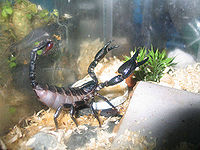Giant forest scorpion
| Giant forest scorpion |
|---|

|
| Scientific Classification |
|
| Species |
|
| The Asian Forest Scorpion (Heterometrus longimanus) comparison to the size of a coin |
The Giant forest scorpions are any of the species of scorpions that belong to the taxonomic genus Heterometrus. It contains approximately 32 different species, most of which have similar appearances and would take an Arachnological (the study Arachnids) or a well trained eye to distinguish differences. They are perhaps best known for their
Anatomy
The genus Heterometrus (Giant Forest Scorpion) is considered to be one of group of scorpion with larger sizes, hence the name giant. With in the Arachnid class, Scorpions in general have a cephalothoraxes (Head and thorax) and an abdomen. They all have a pair of chelicerae (pinchers) and a poison gland on the end of the tail, with a stinger on the end of it. Many of these scorpions within the Heterometrus genus are confused because of their similarities of Emperor scorpion (genus Pandinus), which in fact is the biggest recorded scorpion species. A fully grown Giant forest scorpion is 100 to 200mm from head to tail. It also consists of a variety of colors; mostly starting with shades of mostly black or brown with either hints of blues, light browns, or greens. Some species have reflective shine on their smooth exoskeleton to emphasize the coloration.[1]. Since scorpions have certain proteins within their body, they are able to become fluorescent under ultraviolet light. [2]This is thought to help the scorpion avoid high level uv rays.[3]
Reproduction
All scorpions reproduce sexually and have a complex courtship rituals. Scorpions, like most insects have a unique set of pheromones that attract mates when they are ready. They also communicate in vibrations to attract mates, which is to see if they are satisfied with the other. Then the male will grasp on to the female's pedipalps(mouth)with his own, and then will try to take her to a safe protective place of his choice to release his spermatophore. To entertain the female, the male will sometimes judder or use a cheliceral kiss. This may only take a hour to complete but it could take up to twenty five hours or more depending if the male can find a place. If the male takes to long the female will reject the male and leave. Once the fertilization of the female is done, the male will try to escape from being eaten by the cannibalistic female. [4]
Ecology
Scorpions are mainly nocturnal creatures that hide in small dark places during the day. At night they tend to hunt for small prey. Scorpions have six to twelve pairs eyes but have very poor eye sight that really only detects light but they have many other ways of perception to catch prey. When seeking food, they either use sensory setae (trichobothria/ hair like bristles) on the pedipalps which detect airborne vibrations or the sense organs in the tarsi(claw joint) to locate before attacking. When a target is in range, the scorpion will attack with his chelicerae to grasp it tightly so that it won't get away. The scorpion will then use his stinger if necessary for bigger or stronger opponents that will try to brake free. The genus Heterometrus does not have strong stings, there stinger feels more like a bee sting compared to other scorpions because they have bigger chelicerae to defend themselves. Pedipalps located in the scorpion's mouth and are like smaller chelicerae that rip and grind up food before swallowing when they have finally caught a meal. [5]
Captivity Care
It may be a cool thing to see a scorpion in the wild but there are several people who would prefer to own them as pets. Scorpion within the Heterometrus genus maybe big compared to most scorpion but they are also one of the least aggressive genus. Depending on the species, some can be more aggressive than others but they are great for beginning scorpion care takers. One of the main reasons is because they can live in close quarter with each other. The most available species for pets are Heterometrus spinifer (Asian forest scorpion)and the Heterometrus laoticus (Vietnam forest scorpion). For general Heterometrus care, you would humidity within his living area,1 to 3ft of living space depending on how old it is, some kind of shelter, and live prey. Crickets are recommended for live scorpion food.[6]
Gallery
References
- wikipedia.org unknown author, Wikipedia, last modified on 2 December 2010.
- fireflyforest.net unknown author, The Firefly Forest, November 13, 2006, updated May 12, 2008.
- thaibugs.com unknown author, Scorpion facts, date.
- experiencefestival.com unknown author, Global Oneness, date.
- scorpion.amnh.org Lorenzo Prendini ,Scorpion Systematics Research Group, © 2006 .
- exotic-pets.euDaniel Maney, Exotic-pets.eu, Copyright 2006 .




